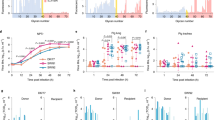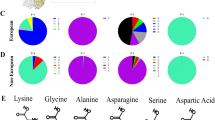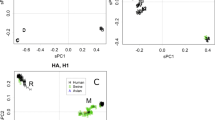Abstract
THE haemagglutinin glycoprotein HA of influenza viruses is responsible for the attachment of the virus to neuraminic acid-containing receptors at the cell surface and subsequent penetration by triggering fusion of the viral envelope with cellular membranes. To express full activity of the newly synthesized precursor, HA has to be modified by post-translational proteolytic cleavage into the polypeptides HA1 and HA2 by cellular enzymes. If proteases suitable for cleavage are not present in the host cell, the resulting virus particles are non-infectious1,2. During adaptation of the apathogenic influenza virus A/turkey/Oregon/71 to chicken embryo cells, which are not permissive for HA cleavage3, we obtained an infectious virus variant with increased pathogenicity. Sequence analysis revealed that during adaptation 54 nucleotides were inserted into the HA gene; their sequence corresponds to a region of the 28S ribosomal RNA. This insertion is probably responsible for increased cleavability of HA, as well as for infec-tivity and pathogenicity of the adapted virus.
This is a preview of subscription content, access via your institution
Access options
Subscribe to this journal
Receive 51 print issues and online access
$199.00 per year
only $3.90 per issue
Buy this article
- Purchase on Springer Link
- Instant access to full article PDF
Prices may be subject to local taxes which are calculated during checkout
Similar content being viewed by others
References
Webster, R. G. & Rott, R. Cell 50, 665–666 (1987).
Klenk, H.-D. & Rott, R. Adv. Virus Res. 34, 247–281 (1988).
Klenk, H.-D., Rott, R., Orlich, M. & Blödorn, Virology 68, 426–439 (1975).
Rott, R. et al. EMBO J. 3, 3329–3332 (1984).
Sanger, F., Nicklen, S. & Coulson, A. R. Proc. natn. Acad. Sci. U.S.A. 74, 5463–5467 (1977).
Gething, M.-I., Doms, R. W., York, D. & White, J. J. Cell Biol. 102, 11–23 (1986).
Chan, Y. L., Olvera, J. & Wool, I. G. Nucleic Acids Res. 11, 7819–7831 (1983).
Hassouna, U., Michot, B. & Bachellerie, J.-P. Nucleic Acids Res. 12, 3563–3599 (1984).
Gonzales, I. L. et al. Proc. natn. Acad. Sci. U.S.A. 82, 7660–7670 (1985).
Jerome, L. et al. J. molec. Evol. 24, 236–251 (1987).
Fields, S. & Winter, G. Cell 28, 303–313 (1982).
Daniels, R. S., Douglas, A. R., Skehel, J. J. & Wiley, D. C. J. gen. Virol. 64, 1657–1662 (1983).
Bosch, F. X., Orlich, M., Klenk, H.-D. & Rott, R. Virology 95, 197–207 (1979).
Author information
Authors and Affiliations
Rights and permissions
About this article
Cite this article
Khatchikian, D., Orlich, M. & Rott, R. Increased viral pathogenicity after insertion of a 28S ribosomal RNA sequence into the haemagglutinin gene of an influenza virus. Nature 340, 156–157 (1989). https://doi.org/10.1038/340156a0
Received:
Accepted:
Issue Date:
DOI: https://doi.org/10.1038/340156a0
This article is cited by
-
Virus–Host Coevolution with a Focus on Animal and Human DNA Viruses
Journal of Molecular Evolution (2020)
-
Recombination of host cell mRNA with the Asia 1 foot-and-mouth disease virus genome in cell suspension culture
Archives of Virology (2019)
-
Importance of the 1+7 configuration of ribonucleoprotein complexes for influenza A virus genome packaging
Nature Communications (2018)
-
The highly pathogenic H7N3 avian influenza strain from July 2012 in Mexico acquired an extended cleavage site through recombination with host 28S rRNA
Virology Journal (2013)
Comments
By submitting a comment you agree to abide by our Terms and Community Guidelines. If you find something abusive or that does not comply with our terms or guidelines please flag it as inappropriate.



